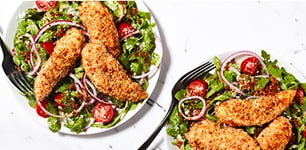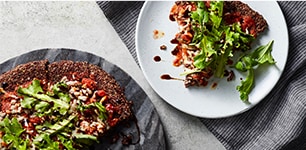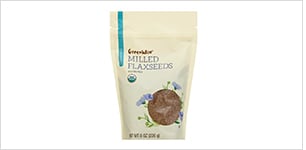Seeds may be small, but they pack a punch of flavor and nutrition. Whether you’re vegetarian, vegan, or just enjoying plant-based foods, seeds are nutrient-dense and versatile.
Let’s explore the nutrient profiles and potential health benefits of five types of seeds. Plus, learn easy ways to add them to your meals and snacks.
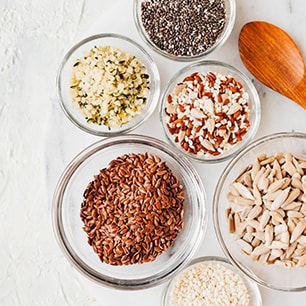
Sowing Seeds of Nutrition
As part of a balanced diet, seeds align with the 2015–2020 Dietary Guidelines for Americans recommendations to consume varied proteins and monounsaturated and polyunsaturated fats. Some evidence has shown that replacing saturated fats with plant sources of unsaturated fats may be associated with a reduced risk of cardiovascular disease.1 Seeds provide protein and unsaturated fats as well as an array of nutrients as shown below.2
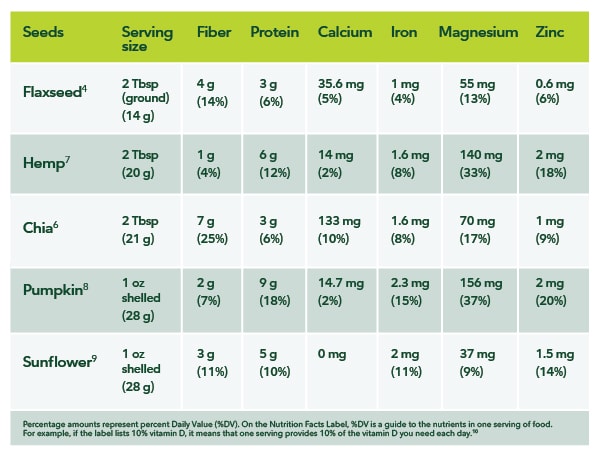
A Trio of Seeds with Big Benefits
Flax, chia, and hemp seeds have gained popularity in recent years, and with good reason. Besides containing magnesium, this trio of seeds offers a variety of other nutrients including omega-3 fatty acids (polyunsaturated fats) in the form of alpha-linolenic acid (ALA). ALA is an essential fatty acid—your body cannot make it, so you must get it from foods and beverages. Recommended daily amounts of ALA are 1.1 grams for women and 1.6 grams for men.3
Flaxseeds
Per 2 tablespoons, flaxseeds are a good source of fiber and magnesium, and they contain twice the recommended daily amount of ALA (3.2 grams). Be sure to buy ground flaxseeds or grind whole seeds in a coffee or spice grinder to make them more easily digestible and to ensure they deliver full nutritional benefits.4
Storage tip: Store flaxseeds in a sealed container for up to one year, and refrigerate after opening.
Baking tip: Flaxseeds make great egg substitutes in your favorite baked good recipes. In place of 1 egg, mix 1 tablespoon of ground flaxseeds with 1 tablespoon of water and let stand for 10 minutes.5 Try it in our Power Play Cookies with Nuts recipe!
Chia Seeds
Per 2 tablespoons, chia seeds are an excellent source of fiber and a good source of calcium and magnesium. Plus, they contain 3.7 grams of ALA. When added to water, chia seeds expand and form a thick texture.6
Serving tip: Make an easy chia pudding! Mix chia seeds and milk (dairy or plant-based) in a jar or bowl; refrigerate overnight and serve. Experiment with your own pudding additions or enjoy our Peanut Butter-Banana Chia Pudding recipe.
Hemp Seeds
Per 2 tablespoons, hemp seeds are an excellent source of magnesium and a good source of protein and zinc. They also contain 1.8 grams of ALA. Hemp seeds are typically hulled to remove their outer shells, and what remains is the heart, with a slightly crunchy, delightfully chewy texture.7
Serving tip: Add hemp seeds to your oatmeal or yogurt for a protein boost.
A Winning Duo: Pumpkin and Sunflower Seeds
Pumpkin and sunflower seeds make yummy snacks and add flavorful crunch to soups and salads. Per 2 tablespoons, both types of seeds are good sources of protein and iron. Pumpkin seeds are an excellent source of magnesium and zinc.8 Sunflower seeds are a good source of zinc.9
Pumpkin seed tip: You may purchase preroasted pumpkin seeds or roast them at home. When preparing your favorite holiday pumpkin or squash recipes, save the seeds and roast them in the oven with olive oil and salt. Check out this simple Roasted Pumpkin Seeds recipe.
Sunflower seed tip: Pick up shelled sunflower seeds for a quick meal enhancement or snack. Or you may prefer the kind with shells (popular with baseball players and fans). Either way, be sure to check the sodium content, as flavored sunflower seeds may be high in sodium.
Seed Your Food Prep
Boost nutrition and flavor in your meals and snacks by including seeds. The possibilities are endless! Here are some easy ways to get started.
Breakfast:
- Add flax, chia, and hemp seeds to your favorite ready-to-eat cereal or oatmeal. Mix them directly into your oatmeal when you cook it, or sprinkle them on top just before eating.
- Prepare our Overnight Apple-Berry Oats, featuring chia seeds.
- Blend flaxseeds into your own smoothie concoction—or in our tasty Blueberry-Spinach Smoothie.
- Mix chia, flax, or hemp seeds into your favorite baked goods, like bread, muffins, and granola bars.
Lunch & Dinner:
- Sprinkle seeds on your salad, rice bowl, or stir-fry dish for a little crunch.
- Add thickness and fiber to your salad dressing with chia seeds.
- Top your soup with pumpkin or sunflower seeds. Savor our fall-inspired Apple-Sweet Potato Soup with Apple Yogurt Topper.
- Relish our Indian-Spiced Squash and Chicken Bowl topped with pepitas (pumpkin seeds).
- Make your Thanksgiving sides more festive and flavorful with seeds. Add them to your family favorites, and consider our Roasted Winter Vegetable Salad topped with sunflower seeds.
- Combine seeds with bread crumbs for a crunchy coating ideal for fish or chicken. Our Flaxseed Salmon with Cucumber-Tomato Salsa and Seed-Breaded Chicken with Arugula recipes offer delicious ways to do this.
- Homemade pizza crust is just begging for seeds. Prepare our Quinoa-Flax Pizza Margherita as a light lunch or appetizer.
Snacks:
- Seeds add texture and crunch to your favorite yogurt or sliced fruit.
- Make your own trail mix with seeds, nuts, dried fruits, and cereals.
- Grab some roasted pumpkin seeds or shelled raw sunflower seeds for a snack on the go.
- Find an easy snack recipe, such as our No-Bake Blueberry Bites or Nutty Fruit Squares.
- Look for packaged snacks—such as chips, granola bars, and cookies—that contain seeds. Check the labels to see if seeds are one of the first few ingredients and whether the product meets your nutrition goals.
For the Love of You
Choosing how you eat is uniquely personal. It’s about your needs, your preferences, and your goals. As your wellness ally, we’re in your corner with fresh ideas, recipes, and wellness icons that make it easier to shift toward wiser food choices. It’s all about you, at your very best.
Sources
1 U.S. Department of Health & Human Services (HHS). A Closer Look Inside Healthy Eating Patterns. 2015-2020 Dietary Guidelines for Americans, 8th ed. November 21, 2016.
2 U.S. Department of Health & Human Services (HHS). Appendix 3. USDA Food Patterns: Healthy US-Style Eating Pattern. 2015-2020 Dietary Guidelines for Americans, 8th ed. November 21, 2016.
3 National Institutes of Health (NIH): Office of Dietary Supplements. Omega-3 Fatty Acids Fact Sheet for Consumers. U.S. Department of Health & Human Services (HHS). July 11, 2019.
4 FoodData Central. Seeds, flaxseed. U.S. Department of Agriculture (USDA): Agricultural Research Service. Accessed August 20, 2020.
5 Cording, Jessica, MS, RD, CDN. CPE Monthly: The Role of Flax in the Diet — Learn About Its Nutritional Content and Potential to Help Prevent and Manage Various Medical Conditions. Today's Dietitian 18, no. 8 (August 2016): 48.
6 FoodData Central. Seeds, chia seeds, dried. U.S. Department of Agriculture (USDA): Agricultural Research Service. Accessed August 20, 2020.
7 FoodData Central. Seeds, hemp seed, hulled. U.S. Department of Agriculture (USDA): Agricultural Research Service. Accessed August 20, 2020.
8 FoodData Central. Pumpkin seeds, unsalted. U.S. Department of Agriculture (USDA): Agricultural Research Service. Accessed August 20, 2020.
9 FoodData Central. Seeds, sunflower seed kernels, toasted, without salt. U.S. Department of Agriculture (USDA): Agricultural Research Service. Accessed August 20, 2020.
10 Zeratsky, Katherine, RD, LD. What do the Daily Value numbers mean on food labels? Mayo Clinic. May 3, 2019.

 You are about to leave publix.com and enter the Instacart site that they operate and control. Publix’s delivery and curbside pickup item prices are higher than item prices in physical store locations. Prices are based on data collected in store and are subject to delays and errors. Fees, tips & taxes may apply. Subject to terms & availability. Publix Liquors orders cannot be combined with grocery delivery. Drink Responsibly. Be 21. For prescription delivery, log in to your pharmacy account by using the Publix Pharmacy app or visiting
You are about to leave publix.com and enter the Instacart site that they operate and control. Publix’s delivery and curbside pickup item prices are higher than item prices in physical store locations. Prices are based on data collected in store and are subject to delays and errors. Fees, tips & taxes may apply. Subject to terms & availability. Publix Liquors orders cannot be combined with grocery delivery. Drink Responsibly. Be 21. For prescription delivery, log in to your pharmacy account by using the Publix Pharmacy app or visiting 